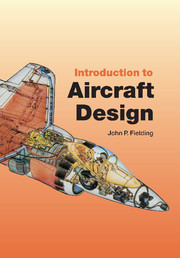Book contents
- Frontmatter
- Contents
- Preface
- Acknowledgements
- 1 Introduction
- 2 Why should we design a new aircraft?
- 3 Why is it that shape? – Civil aircraft
- 4 Why is it that shape? – Other types
- 5 What's under the skin? – Structure and propulsion
- 6 What's under the skin? – Airframe systems
- 7 What's under the skin? – Avionics, flight control and weapon systems
- 8 Why do aircraft cost so much?
- 9 What help can I get? – Bibliography and computer-aided design
- 10 The shape of things to come – Should the project continue?
- 11 What can go wrong? – Some lessons from past aircraft projects, and a glimpse into the future
- Appendix A Useful aircraft design data
- Appendix B A–90 parametric study. Example – the A-90 500-seat airliner
- Appendix C The prediction of aircraft reliability and maintainability targets
- References
- Index
Appendix C - The prediction of aircraft reliability and maintainability targets
- Frontmatter
- Contents
- Preface
- Acknowledgements
- 1 Introduction
- 2 Why should we design a new aircraft?
- 3 Why is it that shape? – Civil aircraft
- 4 Why is it that shape? – Other types
- 5 What's under the skin? – Structure and propulsion
- 6 What's under the skin? – Airframe systems
- 7 What's under the skin? – Avionics, flight control and weapon systems
- 8 Why do aircraft cost so much?
- 9 What help can I get? – Bibliography and computer-aided design
- 10 The shape of things to come – Should the project continue?
- 11 What can go wrong? – Some lessons from past aircraft projects, and a glimpse into the future
- Appendix A Useful aircraft design data
- Appendix B A–90 parametric study. Example – the A-90 500-seat airliner
- Appendix C The prediction of aircraft reliability and maintainability targets
- References
- Index
Summary
Introduction
The author and V C Serghides have performed statistical analyses to produce combat aircraft reliability and maintainability prediction methods. These are applicable for use at the conceptual design stage, because they only require the use of readily-available parameters such as wing span, engine thrust, mass, etc. These methods predict whole-aircraft values of confirmed defects per 1000 flying hours and defect maintenance hours per 100 flying hours. Predictions are also made for individual systems and allowances may be made for technology improvements, relative to the empirical data-base used in the method derivation. These may be used as targets for reliability performance of individual systems during the preliminary design stage.
Earlier work by the author produced a similar method for the prediction of commercial aircraft dispatch reliability. The whole-aircraft equations produced are reproduced in Section C2, below.
Commercial aircraft dispatch reliability prediction
The work reported in ref C2 showed that some systems exhibited different traits according to the type of airline operation. For example long-haul aircraft tended to have higher delay rates because they may be away from their home base for more than a week, and defects might accumulate, whereas short-haul aircraft tended to return to their home-bases more often. Other considerations were also affected by the operational type, in such things as Chapter 28 – fuel systems, where long-haul aircraft had more complicated systems which were more delay-prone than those of short-haul aircraft.
- Type
- Chapter
- Information
- Introduction to Aircraft Design , pp. 255 - 258Publisher: Cambridge University PressPrint publication year: 1999



